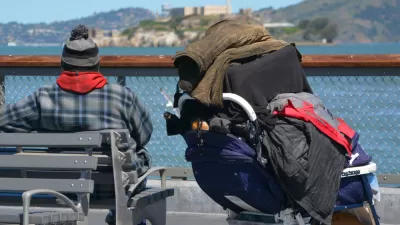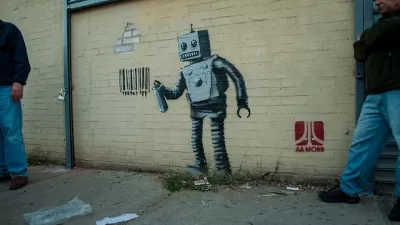Thanks to a $3 million anonymous donation, San Francisco has built a first-of-its kind temporary shelter that will welcome homeless campers along with their belongings and pets.
Key to the success of the shelter, technically considered a pilot program, will be its ability to evaluate the residents "to determine what is needed: a trip back to their home city to live with family, to be considered for permanent housing or for drug-treatment or mental-health services," writes The Wall Street Journal's West Coast reporter, Alejandro Lazo. And they'll have to do that during the ten days they'll be there. [See SF Gate Photogallery]
Lazo writes how other cities have dealt with their homeless populations, including those "with large-scale intake centers ...(b)ut few places, if any, have tried an approach that pairs an intake center with the potential for access to permanent housing and social services, city officials and national experts said," writes Lazo.
The Navigation Center, as it is formerly called, will only be a temporary fixture, up to 18 months, in the MIssion District. "After that, the site is slated to be developed into below-market-rate housing," adds Lazo.
The initial population the center, located at 1950 Mission Street near the 16th Street BART station, hopes to serve is "the estimated 400 homeless people that live in surrounding blocks," writes Lazo.
Finding permanent rental housing in "The City" is difficult even for middle income people, as any one who has looked for housing here will tell you. "The average asking rent at the end of 2014 for a studio apartment was $2,575, an 11% increase from 2013, according to the firm RealFacts," adds Lazo.
FULL STORY: San Francisco tries a new tack in combating homelessness

Alabama: Trump Terminates Settlements for Black Communities Harmed By Raw Sewage
Trump deemed the landmark civil rights agreement “illegal DEI and environmental justice policy.”

Planetizen Federal Action Tracker
A weekly monitor of how Trump’s orders and actions are impacting planners and planning in America.

Why Should We Subsidize Public Transportation?
Many public transit agencies face financial stress due to rising costs, declining fare revenue, and declining subsidies. Transit advocates must provide a strong business case for increasing public transit funding.

Understanding Road Diets
An explainer from Momentum highlights the advantages of reducing vehicle lanes in favor of more bike, transit, and pedestrian infrastructure.

New California Law Regulates Warehouse Pollution
A new law tightens building and emissions regulations for large distribution warehouses to mitigate air pollution and traffic in surrounding communities.

Phoenix Announces Opening Date for Light Rail Extension
The South Central extension will connect South Phoenix to downtown and other major hubs starting on June 7.
Urban Design for Planners 1: Software Tools
This six-course series explores essential urban design concepts using open source software and equips planners with the tools they need to participate fully in the urban design process.
Planning for Universal Design
Learn the tools for implementing Universal Design in planning regulations.
Caltrans
Smith Gee Studio
Institute for Housing and Urban Development Studies (IHS)
City of Grandview
Harvard GSD Executive Education
Toledo-Lucas County Plan Commissions
Salt Lake City
NYU Wagner Graduate School of Public Service





























